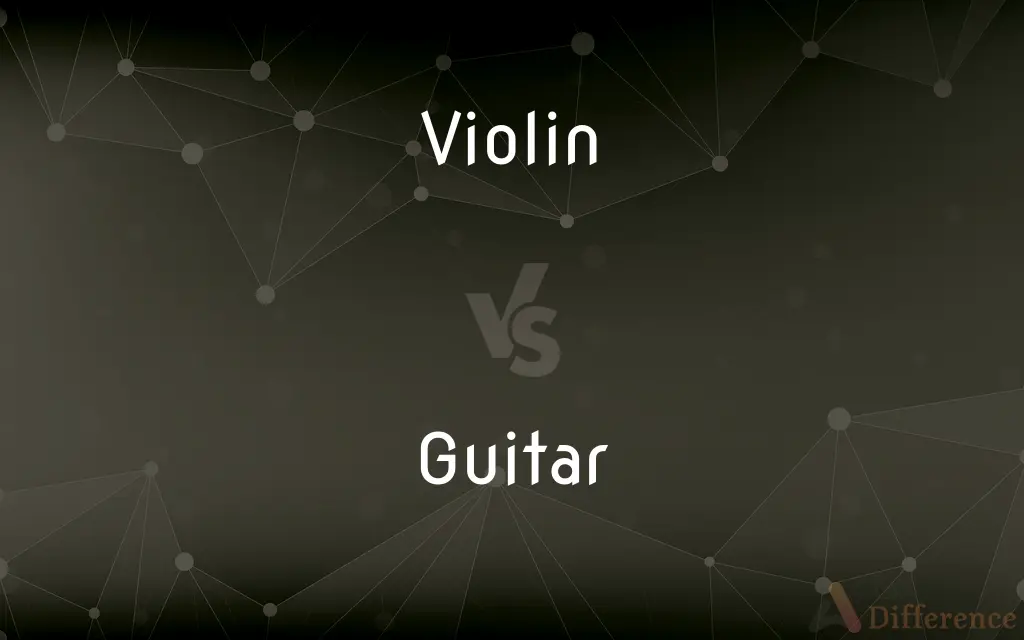Violin vs. Guitar — What's the Difference?
By Maham Liaqat & Fiza Rafique — Updated on March 14, 2024
The violin is a bowed string instrument known for its use in classical and folk music, offering a high-pitched, expressive sound. The guitar is a plucked string instrument, versatile across many genres, producing a wider range of tones.

Difference Between Violin and Guitar
Table of Contents
ADVERTISEMENT
Key Differences
The violin, often associated with orchestras and chamber music, is played with a bow that vibrates its strings, producing a sound that is rich in harmonics and capable of a wide range of dynamics and expressive techniques. It typically has four strings tuned in perfect fifths and is held between the shoulder and the chin, facilitating intricate fingerwork for melody and harmony. In contrast, the guitar, popular in genres like rock, jazz, and classical, is played by plucking or strumming the strings with fingers or a pick. Guitars usually have six strings, though variations with more strings exist, and are tuned in fourths with a major third. The guitar's body acts as a resonating chamber, amplifying the sound produced by the strings. This instrument can be acoustic, relying on its body for sound projection, or electric, using pickups and amplifiers to produce sound.
The violin's size and design contribute to its distinctive voice in music, capable of both powerful projection and delicate subtlety. The guitar is known for its harmonic and rhythmic capabilities, making it a foundational instrument in many bands and musical groups.
While both instruments require significant skill and practice to master, the approach to playing and the role they play in music differ greatly. The violin's repertoire is extensive in classical and folk traditions, where its ability to mimic the human voice and express a wide range of emotions is unparalleled. On the other hand, the guitar's versatility makes it a staple in both solo and ensemble settings, capable of providing rhythm, harmony, and melody, often simultaneously.
The physical interaction with each instrument also contrasts; violinists develop a technique that involves precise bow control and finger placement within a fretless fingerboard, demanding acute aural skills for intonation. Guitarists, whether playing an acoustic or electric guitar, navigate a fretted fingerboard that guides finger placement, with skills such as chord voicing, fingerpicking, and strumming patterns central to various playing styles.
The choice between violin and guitar depends on the musical genres one is drawn to, the roles one wishes to play within musical compositions, and personal preference for the sound and playing techniques of each instrument.
ADVERTISEMENT
Comparison Chart
Strings
Typically 4, tuned in perfect fifths.
Usually 6, tuned in fourths with a major third.
Play Style
Played with a bow.
Plucked or strummed with fingers or a pick.
Music Genres
Classical, folk, baroque.
Rock, jazz, blues, classical, pop.
Sound Production
Vibrates strings with a bow.
Plucks strings, uses body for resonance.
Holding Position
Between shoulder and chin.
Held horizontally against the body.
Fingerboard
Fretless, demands precise finger placement.
Fretted, guides finger placement.
Sound Range
High-pitched, expressive.
Wide range, from deep bass to bright treble.
Role in Music
Melody and harmony, expressive solos.
Rhythm, harmony, melody, versatile roles.
Amplification
Acoustic, sometimes uses microphones.
Acoustic or electric with amplifiers.
Repertoire
Extensive in classical and folk music.
Versatile across many genres.
Compare with Definitions
Violin
Known for its emotional depth and expressive capabilities.
The violinist used vibrato to enhance the piece's expressiveness.
Guitar
Can be acoustic or electric, with six strings standard.
She played an acoustic guitar around the campfire, singing folk songs.
Violin
A bowed string instrument with a high-pitched, expressive sound.
The violin solo in the orchestra moved the audience to tears.
Guitar
Fretted fingerboard facilitates chord voicing and soloing.
The guitarist's mastery over complex chords amazed the listeners.
Violin
Held between the shoulder and chin, played with a bow.
He adjusted his grip on the violin before beginning the concerto.
Guitar
A plucked string instrument, versatile in many music genres.
The guitarist's solo captivated the audience with its complexity.
Violin
Requires precise technique and ear training for intonation.
The young violinist's intonation improved with each lesson.
Guitar
Played by strumming or plucking the strings, held horizontally.
The blues musician fingerpicked his guitar with soulful precision.
Violin
Used primarily in classical, baroque, and folk music.
She practiced a complex piece from the violin's classical repertoire.
Guitar
Serves as a foundational instrument in bands for rhythm and melody.
The band's guitarists laid down a powerful rhythmic foundation.
Violin
The violin, sometimes known as a fiddle, is a wooden chordophone (string instrument) in the violin family. Most violins have a hollow wooden body.
Guitar
The guitar is a fretted musical instrument that typically has six strings. It is held flat against the player's body and played by strumming or plucking the strings with the dominant hand, while simultaneously pressing selected strings against frets with the fingers of the opposite hand.
Violin
A stringed instrument played with a bow, having four strings tuned at intervals of a fifth, an unfretted fingerboard, and a shallower body than the viol and capable of great flexibility in range, tone, and dynamics.
Guitar
A stringed musical instrument, with a fretted fingerboard, typically incurved sides, and six or twelve strings, played by plucking or strumming with the fingers or a plectrum.
Violin
A small unfretted stringed instrument with four strings tuned (lowest to highest) G-D-A-E, usually held against the chin and played with a bow.
When I play it like this, it's a fiddle; when I play it like this, it's a violin.
Guitar
A musical instrument having a flat-backed rounded body that narrows in the middle, a long fretted neck, and usually six strings, played by strumming or plucking.
Violin
Any instrument of the violin family, always inclusive of violins, violas, and cellos and sometimes further including the double bass.
The string quartet, one of the most popular groupings in chamber music, is composed entirely of violins: two violins proper, one viola, and one cello.
Guitar
(musical instrument) A stringed musical instrument, of European origin, usually with a fretted fingerboard and six strings, played with the fingers or a plectrum (guitar pick).
Learning to strum the guitar rhythmically is essential.
She was carrying her guitar in a fancily-decorated case.
The band is looking for a new guitar player.
Violin
The position of a violinist in an orchestra or group.
The first violin often plays the lead melody lines in a string quartet.
Guitar
(musical instrument) Any type of musical instrument of the lute family, characterized by a flat back, along with a neck whose upper surface is in the same plane as the soundboard, with strings along the neck and parallel to the soundboard.
Violin
(ambitransitive) To play on, or as if on, a violin.
Guitar
(rare) To play the guitar.
Violin
A small instrument with four strings, played with a bow; a fiddle.
Guitar
A stringed instrument of music resembling the lute or the violin, but larger, and having six strings, three of silk covered with silver wire, and three of catgut, - played upon with the fingers.
Violin
Bowed stringed instrument that is the highest member of the violin family; this instrument has four strings and a hollow body and an unfretted fingerboard and is played with a bow
Guitar
A stringed instrument usually having six strings; played by strumming or plucking
Common Curiosities
Which is easier to learn, violin or guitar?
Ease of learning varies by individual; the guitar may be initially easier due to its fretted fingerboard and playing position, but mastery of either instrument requires dedication.
Is it possible to self-teach violin or guitar?
While both instruments can be self-taught, especially with available online resources, formal lessons can significantly improve technique and musicality.
What's the difference between acoustic and electric guitars?
Acoustic guitars produce sound through their body's resonance, suitable for unplugged settings, while electric guitars require an amplifier to project sound, offering a wide range of effects and tones.
Can the violin be used in modern music genres?
Yes, the violin is used in many modern music genres, including rock, jazz, and pop, often bringing a unique and expressive sound.
Which instrument has a wider range of sound?
The guitar has a wider range of sound, from deep bass to bright treble notes, making it versatile across various musical styles.
What kind of maintenance do violins and guitars require?
Both require regular maintenance, including cleaning and tuning. Violins may need bow rehairing and occasional adjustments by a luthier, while guitars might need string changes and adjustments to action or intonation.
Can electric guitars mimic other instruments?
With the use of effects pedals and synthesizers, electric guitars can mimic a wide range of instruments and sounds, offering creative flexibility.
How do the roles of violin and guitar differ in an ensemble?
In an ensemble, violins often carry the melody or play intricate harmonies in classical settings, while guitars provide rhythm, harmony, and sometimes lead melodies in bands and other musical groups.
Do you need to read music to play violin or guitar?
Reading music can enhance your understanding and repertoire for both instruments, but many guitarists also learn through tablature, which doesn't require traditional music reading skills.
What makes the violin uniquely expressive?
The violin's expressiveness comes from melody.
Share Your Discovery

Previous Comparison
Pronoun vs. Nominal
Next Comparison
Matter vs. AffairAuthor Spotlight
Written by
Maham LiaqatCo-written by
Fiza RafiqueFiza Rafique is a skilled content writer at AskDifference.com, where she meticulously refines and enhances written pieces. Drawing from her vast editorial expertise, Fiza ensures clarity, accuracy, and precision in every article. Passionate about language, she continually seeks to elevate the quality of content for readers worldwide.
















































